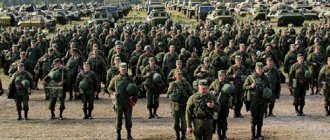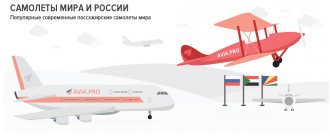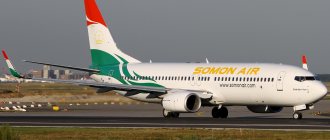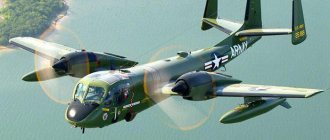The two most powerful powers in the world have the most powerful air fleets. These are Russia and the United States of America. Both countries are constantly improving them. New military aircraft are produced, if not annually, then every two to three years. Huge funds are allocated for development in this area.
If we talk about Russian strategic aviation, then do not expect that you will be able to find accurate statistical data anywhere on the number of attack aircraft, fighters, etc. in service. Such information is considered top secret. Therefore, the information provided in this article may be subjective.
Russian Aviation
In 2022, deliveries of new aircraft to the Russian Armed Forces decreased compared to previous years, and in quantitative terms fell to approximately the 2013 level. This is due to the fact that currently the Russian Ministry of Defense actually supports only three serial procurement programs in the field of combat aviation (Su-30SM, Su-34 and Su-35S), and the annual pace of purchases for them is somewhat decreasing. At the same time, the Russian Armed Forces are experiencing a shortage of flight personnel to operate existing aircraft.
In total, according to known data, in 2022 the Russian Armed Forces received 50 new combat aircraft, of which: 14 Su-30SM, 12 Su-34, 10 Su-35S and 14 Yak-130 combat training aircraft. Six more Su-27SM3 aircraft were transferred to the Aerospace Forces after modernization.
MiG-31K
On March 1, 2022, in a message to the Federal Assembly, Russian President Vladimir Putin announced data on new weapons being prepared for entry into the Russian army. One of the new products was the Kinzhal high-precision hypersonic aeroballistic missile system. Later it became known that in the Southern Military District there are ten MiG-31K complexes equipped with this missile on combat duty. The complexes patrol the waters of the Black and Caspian Seas, providing strategic deterrence. In 2022, they completed 89 flights as part of experimental combat duty.
At the beginning of July, it became known that long-range missile carriers Tu-22M3 will also be armed with these missiles; the aircraft will receive four “Daggers” on external slings - two each under the wing and fuselage.
"Dagger" will cover strategic directions from sea and ocean waters
Su-57 The calling card of Russian aviation in 2018 was the fifth-generation fighter Su-57, which combines the functions of an attack aircraft and a fighter. When designing this machine, the most modern technologies of military aircraft construction were used.
In February 2022, a pair of Su-57s were tested in combat conditions in Syria. The Ministry of Defense does not disclose detailed information about the tests carried out, but there have been reports in the media about the practical launches of promising operational-tactical cruise missiles.
It is expected that in 2022, all development work on the fighter should be completed, and the first two production aircraft will arrive at the Lipetsk Aviation Center for combat pilots to master the machines.
During the year, various media both in Russia and abroad wrote a lot about the fact that the Russian Ministry of Defense is abandoning this aircraft because of its high cost, and our country cannot afford the production of a modern high-tech technology. However, the military department has never announced the abandonment of the Su-57, but there have been reports that Russia, in conditions where the country is not threatened with direct military intervention, is protected by its existing fleet of modern fighters, including such as the Su-30SM and Su- 35C.
Moreover, the Su-35S is currently the most advanced 4++ generation fighter from the entire fleet of global combat aviation; it is equipped with equipment and technological solutions characteristic of fifth-generation aircraft. Therefore, the Su-57 is considered as a medium-term aircraft - its mass production and deliveries to the Aerospace Forces can be expected in the 2028-2030 horizon, when the modernization potential of the previous generation aircraft will be exhausted.
The implementation of foreign programs for fifth-generation fighters within 10-15 years will significantly change the balance of power in the world. Therefore, work on the Su-57, its further improvement and introduction into series, is of particular relevance.
Victor Bondarev: experts classify the Su-57 as generation 5+
MiG-35 During 2022, a number of air-to-air and air-to-surface aircraft weapons systems, as well as elements of avionics (avionics) were tested at the aviation center in Akhtubinsk. By the end of the year, the integrated management system (IMS) was in the active phase of inspections. Two pre-production aircraft performed flights to test aerodynamic stability and maneuverability. It is planned to complete all necessary tests of the aircraft in 2019.
In August, as part of the Army 2018 exhibition, the Ministry of Defense signed a contract for the supply of the first production batch of six fighters to the Russian Aerospace Forces. As of January 1, 2022, it was known that RSK MiG was completing the final assembly of the first batch of aircraft and was preparing to conduct their acceptance tests. The first batch of their four vehicles will be delivered to the Ministry of Defense during 2019.
Su-34 During 2022, the Novosibirsk Aviation Plant delivered 12 Su-34 front-line bombers to the Russian Aerospace Forces. All 12 aircraft were built by NAZ according to the state defense order of 2022, they arrived for the re-equipment of the 2nd Guards Bomber Aviation Regiment of the 21st Mixed Aviation Division of the 14th Smolensk Red Banner Army of the Air Force and Air Defense of the Central Military District, stationed at the Shagol airfield (Chelyabinsk): on May 22, two aircraft , May 29, two planes, October 18, two planes, and two planes each on December 6, December 19, and December 22, 2022.
All 12 aircraft were transferred under a contract with the Russian Ministry of Defense dated February 2012 for 92 such aircraft. With their delivery, the total number of aircraft of this type transferred to the Aerospace Forces under the 2012 contract reached 82 units. The first two Su-34s under this contract were transferred to the Russian Air Force on December 24, 2013, the next 18 aircraft - in 2014, another 18 aircraft - in 2015, 16 - in 2016, 16 - in 2022, and 12 - in 2022 year. The total number of Su-34s built under all contracts, including seven prototypes and pre-production models, reached 126 units as of January 1, 2022.
Su-30SM By order of the President of the Russian Federation dated January 12, 2022, the Su-30SM multirole fighter was adopted by the Russian Air Force.
On December 20-22, 2022, a Su-30SM fighter with tail number “62 red” (RF-61773, s/n 10MK5 1602) flew from Irkutsk to the Khalino airfield (Kursk). This is the last fighter of this type, built at the Irkutsk Aviation Plant under the state defense order in 2022. In total, in 2022, the aircraft plant transferred 14 Su-30SM aircraft to the Ministry of Defense, including 12 for the Russian Aerospace Forces and two for the Naval Aviation of the Russian Navy.
The first four Su-30SM fighters arrived in Halino on April 27, 2018, on July 3 - two more aircraft, on September 8 - four fighters, on November 30 one fighter arrived and on December 22 the last Su-30SM fighter was transferred.
In total, since 2012, 116 Su-30SM aircraft have been contracted for the Ministry of Defense, of which, as of January 1, 2022, the Aerospace Forces received 92 fighters, and Naval Aviation received 22.
Su-35S In 2022, the Russian Aerospace Forces received ten Su-35S fighters under the state defense order. The aircraft were manufactured under a five-year contract concluded in December 2015 for the supply of 50 fighters. The first ten Su-35S aircraft under this contract were built by KnAAZ in 2016, ten more aircraft in 2022, and another ten fighters in 2022.
Taking into account the first contract in 2009 for 48 Su-35S fighters, the Russian Aerospace Forces received 78 production Su-35S aircraft from the end of 2012 to January 1, 2022. Taking into account 24 Su-35 export modification fighters built in 2016-2018 and delivered to China under a 2015 contract, a total of 102 production Su-35S fighters were built in Komsomolsk-on-Amur.
As of January 1, 2022, the status of fulfillment of contracts for the supply of Sukhoi aircraft to the Russian Aerospace Forces is as follows:
- Su-34: Under several contracts with the Ministry of Defense, since 2006, 128 serial Su-34 front-line bombers have been ordered for the Aerospace Forces, 120 of them have been delivered.
- Su-30SM: Under several contracts of the Ministry of Defense, since 2012, 116 Su-30SM fighters have been ordered for aerospace forces and naval aviation, 114 of them have been delivered.
- Su-35S: Under two contracts with the Ministry of Defense, since 2009, 98 Su-35S fighters have been ordered for the Aerospace Forces, 78 of them have been delivered.
Yak-130 In 2022, Irkutsk Aviation Irkut supplied the Russian Aerospace Forces with 14 Yak-130 combat training aircraft. However, only six of them were aircraft built in 2022, and the remaining eight aircraft were built back in 2022, but were delayed with the transfer of the Aerospace Forces. The transfer of Yak-130 aircraft was suspended due to ongoing modifications to aircraft of this type after two flight accidents with the Yak-130 took place on the same day, June 21, 2022.
In March, the Aerospace Forces received four aircraft built in 2022, in June - four more, in July IAZ transferred three aircraft to the Aerospace Forces, and on October 8 - the last three aircraft of the 2022 program.
On November 21, 2022, the Ministry of Defense announced that the next batch of Yak-130 combat training aircraft had arrived at the Kushchevskaya air base. In total, in 2022, the training air base of the Krasnodar Higher Military Aviation School of Pilots named after. A.K. Serov in the Kushchevsky district of Kuban, 10 Yak-130s were transferred.
All these 14 aircraft were the last aircraft built by IAZ as part of the contract for the supply of 30 Yak-130 aircraft to the Russian Aerospace Forces by the end of 2022, concluded by the Ministry of Defense in April 2016.
The total number of serial Yak-130s delivered to the Russian Ministry of Defense reached 109 units - of which 12 of the first two series were built at Nizhny Novgorod Air Force, and another 97 in Irkutsk.
Deliveries of combat aircraft in 2008-2018
| Type | 2008 | 2009 | 2010 | 2011 | 2012 | 2013 | 2014 | 2015 | 2016 | 2017 | 2018 |
| MiG-29STM | — | 28 | — | — | — | — | — | 4 | 12 | — | — |
| MiG29UMB | — | 6 | — | — | — | — | — | 2 | — | — | — |
| MiG-29KR | — | — | — | — | — | 2 | 8 | 10 | — | — | — |
| MiG-29KUBR | — | — | — | — | — | 2 | 2 | — | — | — | — |
| Su-27SM3 | — | — | 4 | 8 | — | — | — | — | — | — | 6 |
| Su-30M2 | — | — | 2 | 2 | — | 3 | 8 | 3 | 2 | — | — |
| Su-30SM | — | — | — | — | 3 | 14 | 21 | 27 | 17 | 17 | 14 |
| Su-34 | 1 | 2 | 4 | 6 | 10 | 14 | 18 | 18 | 16 | 16 | 12 |
| Su-35S | — | — | — | — | 2 | 8 | 24 | 12 | 12 | 10 | 10 |
| Yak-130 | — | 3 | 6 | 3 | 15 | 18 | 20 | 14 | 10 | 6 | 14 |
| Total | 1 | 39 | 16 | 19 | 29 | 61 | 101 | 90 | 69 | 49 | 56 |
According to information from open sources, it is known that in 2022, 26 new combat aircraft were delivered abroad, including 12 MiG-29M/MiG-29M2 fighters to Egypt, four Su-30SM fighters to Kazakhstan and ten Su-35 fighters to China. Ten Yak-130 combat training aircraft: six to Myanmar and four to Laos, which will receive a total of 10 such aircraft. In addition, four Su-30MKI fighters used by the Indian Air Force were delivered to Angola.
* * *
According to Russian Defense Minister Sergei Shoigu, by December 2022, the frequency of Russian military aviation flights in Syria had decreased from 110 per day to 2-4 flights per week. The flights are mainly carried out for additional reconnaissance of the situation.
Long-range aviation
In 2022, long-range aviation units received five modernized strategic missile carriers - one Tu-160M "White Swan" and four Tu-95MS "Bear". In 2022, four more Tu-95MS should be delivered to the troops.
In total, in 2022, the Aerospace Forces received 126 aircraft and helicopters, 9 spacecraft, and 120 pieces of air defense equipment. The share of modern weapons in the air force has reached 64%, and in general in the Aerospace Forces it has increased to 74%.
The modern fleet of Russian Long-Range Aviation consists of Tu-160M and Tu-95MS missile carriers, Tu-22M3 bombers, Il-78 tankers and Tu-22MR reconnaissance aircraft. The composition of the YES (including combat vehicles in storage) numbers almost 120 units: 16 Tu-160, 60 Tu-95, 40 Tu-22M. There are just under 60 strategic missile-carrying bombers in service: 16 Tu-160, 30 Tu-95, 12 Tu-22M. The main location of the RF DA formations is the Engels Guards Aviation Base in the Saratov Region.
Tu-160M/M2 The beginning of 2022 was remembered for the first flight of the new strategic missile carrier Tu-160M, manufactured at the aircraft plant in Kazan as part of the program to resume production of these machines in the guise of the Tu-160M2. The aircraft with serial number 0804, named "Peter Deinekin", was built on the basis of the technological reserve available at the plant, but using the latest components, parts and technologies. The aircraft was being completed to solve the problems of restoring the final assembly technology and testing certain new technological solutions.
The new aircraft is not a prototype of a modernized version of the bomber. During the completion process, minor modernization was carried out: the airframe and engines remained the same. The start of construction of the Tu-160M2 missile carriers is possible only after the digitization of the design documentation; by September, more than 500 thousand design documents had been digitized. In April 2022, it became known that the construction of the first modernized Tu-160M2 missile carrier was already underway.
In November 2022, the strategic missile carrier Tu-160M, after modernization, launched twelve air-launched cruise missiles of the X-101 type at the Pemboy test site, located beyond the Arctic Circle. If we were talking about missiles with special warheads (the X-102 version), then such a nuclear strike would be enough to destroy a small country with an area of up to 10 thousand square meters. km.
Tu-95MS/MSM As part of the deep modernization of the Tu-95MS strategic bomber-missile carrier into the Tu-95MSM version, the aircraft's avionics are being changed, and the aircraft will receive upgraded NK-12MPM engines. Thanks to the modernized power plant, the bomber will significantly improve its flight performance, including increasing its flight range. The first flight of the Tu-95MSM with the upgraded engine is scheduled for the end of 2022.
The NK-12MPM engine, developed by the Samara PJSC Kuznetsov, is a modification of the NK-12MP - the most powerful serial turboprop engine in the world (15,000 hp).
In 2022, four modernized Tu-95MS long-range bombers will be transferred to the Aerospace Forces.
Tu-22M3M On December 28, 2022, the first flight of the deeply modernized long-range missile carrier-bomber Tu-22M3M took place in Kazan; the flight took place at an altitude of 1500 meters and lasted 37 minutes. The ceremony of rolling out and transferring the first prototype of the Tu-22M3M to the stage of ground and flight tests took place on August 16.
From the previous modification of the Tu-22M3, only the airframe remained. The aircraft is equipped with a new set of digital avionics, which is largely unified with the Tu-160M, a new electronic countermeasures system, a new communications complex, a new locator, and a new defense complex. Improvements have been made to the airframe to extend the intended service life of the aircraft.
New modernized, more fuel-efficient engines will be installed on the aircraft, which will increase flight range and speed. In-flight refueling booms will be returned to the new bombers.
According to official data, Russia has more than 100 Tu-22M3 missile carriers.
Tu-22M3M - another “long arm” of Russia
PAK DA Throughout 2022, there were reports of the development of a promising long-range aviation complex (PAK DA). In January, Russian Deputy Prime Minister Dmitry Rogozin said that the Tupolev Design Bureau was starting the active phase of designing the PAK DA. Rogozin noted that the aircraft will be designed according to the “flying wing” design. “Even outwardly it will not be similar to our understanding of the traditional appearance of the aircraft. This is a flying wing, an airplane of the 21st century. But this is the next step,” said the Deputy Prime Minister.
In March, Tupolev PJSC announced that the Kazan Aviation Plant was preparing to assemble the first prototypes of the complex.
On September 3, on the government procurement website, Tupolev PJSC posted a tender for the implementation of a component of the development work on the topic: “Creation of a set of tools for mathematical modeling of general aircraft equipment systems of product 80 (SKV, GS, SES) to solve problems of debugging system control algorithms, diagnostics, fault recovery and semi-natural modeling". According to information from open sources, “product 80” is a promising long-range aviation complex.
In the fall, there were reports that the Samara-based PJSC Kuznetsov had begun R&D work on the engine for Product 80. The contract for the creation of an engine for the PAK DA was concluded between UEC and in June 2022.
- 05/16/2016 “Russian Knights” and “Swifts” will celebrate their anniversary in Kubinka
- 09/30/2016 Composition of the Russian Aerospace Forces in Syria as of September 2016
- 08/31/2017 Tupolev handed over the next modernized long-range aviation systems to the Russian Defense Ministry
- 01/29/2021 UAC reported on the work done in 2022
( 8 ratings, average: 5.00 out of 5)
MIG-35Su-30SMSu-34Su-35SSu-57Tu-160Tu-22M3Tu-95MSYak-130
Tu-95 vs B-52
After the collapse of the USSR, the strategic carrier of nuclear weapons Tu-95 entered the operational composition of Russian aviation. Despite its venerable age, this vehicle continues to serve as a missile carrier. The large, powerful and rugged design allows it to be used as an air-launched launcher, just like its overseas counterpart, the B-52. Both aircraft entered service almost simultaneously and have approximately similar technical characteristics. Both the Tu-95 and the B-52 cost the states dearly at one time, but they were designed and made to last, and therefore have a very long service life. Volumetric bomb bays accommodate cruise missiles (X-55), which can be launched from the side, which creates conditions for delivering a nuclear strike without crossing the border of the attacked country.
After modernizing the Tu-95MS and dismantling the release mechanisms for free-falling ammunition, the Russian long-range aviation actually received a new strategic aircraft equipped with modern navigation equipment and guidance systems.
Conditionally strategic Tu-22
The structure of strategic aviation in the USSR and Russia has much in common. The aircraft fleet is inherited, it can serve for a long time, but mainly consists of two types of aircraft - Tu-95 and Tu-160. But there is another bomber that does not fully meet the strategic mission, although it can make a decisive contribution to the outcome of a global conflict. The Tu-22M is not considered heavy and belongs to the medium class; it develops supersonic speed and can carry a large number of cruise missiles. This aircraft does not have the flight range typical of intercontinental bombers, and therefore is considered conditionally strategic. It is designed to strike bases and bridgeheads of a potential enemy located in Asia and Europe.
Will there be new strategic bombers?
Russian strategic aviation currently consists of dozens of aircraft of three main types (Tu-160, Tu-95 and Tu-22). All of them are no longer new, they spent a lot of time in the air and, perhaps, it may seem to someone that these machines need to be replaced. Journalists who are far from military issues sometimes call the Tu-95 “Bear” a relic machine. However, any phenomenon should be considered in comparison. The Americans are not yet planning to scrap their B-52s; sometimes the grandchildren of the first pilots who mastered them fly them, but no one calls these aerial giants junk. As far as we know, our potential adversaries do not yet plan to build new types of strategic bombers, considering them, perhaps, a rapidly aging class of equipment. Most likely, the Russian side will not initiate a new round of the arms race.










